Is t
he
piston engine concept the best for ever?
Why is it so difficult to substitute it?
The Quasiturbine systematic engine concept analysis gives answers...
Theory - Quasiturbine Concept
Quasiturbine Not a Vane Type
The vane-type pumps are known for their very limited engine torques due to the
amplitude of their seal movements, a movement the Quasiturbine brings back
to imperceptible. They have also the major geometrical defect of not
allowing a high geometric compression ratio, which makes them doubly inapt
for combustion engines. The compressible fluid must initially charge in pure
lost the residual chamber volume at Top Dead Center before providing the push, which
destroys their efficiency. An efficient positive expansion machine must be
capable of very high geometrical compression ratio, reducing the charging
loss to nearly zero, and this is one of the multiple Quasiturbine
objectives. Furthermore, the Quasiturbine has 2 different compress fluid
circuits (vane motor have only one), which double the torque, as well as
the specific power density.
Origin of the Quasiturbine Idea
The Quasiturbine researcher team has initially established a
list of 30 conceptual piston deficiencies
quasiturbine.promci.qc.ca/ETheoryQTVersusPiston.htm and as many Wankel
deficiencies
quasiturbine.promci.qc.ca/ETheoryQTVersusWankel.htm. The
Quasiturbine general concept
quasiturbine.promci.qc.ca/QTImages/QTBrevet12Fig1Net.jpg is
the result of an effort to improve both engines by suppressing the limiting
sinusoidal crankshaft and offering up to 7 degrees of freedom at design. The inventors have made a systematic analysis of engine
concepts, their value, their weaknesses, and their potential for improvement. All
improvement ideas converged when they suggested to make a turbo-shaft turbine having only
one turbine in one plane... In order to achieve that, the turbine blades had to
attached one to an other in a chain like configuration, where
the rotor acts as compressor for a quarter of a turn, and as engine the next
quarter of a turn... Furthermore, to be able to shape the pressure pulse at will
in order to optimized the thermodynamic and reach photo-detonation, extra
degrees of freedom at design needed to be introduced by a set of peripheral carriages. This
is the Quasiturbine, which is also a theory about efficient engine!
It is a type of rotary engine
invented by the Saint-Hilaire
family and first patented in the general configuration
quasiturbine.promci.qc.ca/QTImages/QTBrevet12Fig1Net.jpg in 1996. The engine uses a four-sided
articulated rotor supported by carriages that turns within a complex computer calculated oval
shape creating regions of increasing and decreasing volumes as the rotor
turns. The Quasiturbine design can also be used as an air motor, steam
engine, gas compressor or pump. It is capable of burning fuel using
photo-detonation, an optimal combustion mode of the future the piston cannot support...
Prior Art: « La
principale raison pour laquelle les concepts du 20 ième siècle ne se sont pas
développés résulte du fait qu'ils sont statiques et que les prototypes
correspondants ne tournent pas correctement, ni ne sont fonctionnels. Il aura fallu attendre la venue de
puissants ordinateurs personnels à la fins des années 1980, et les travaux de
simulation numérique de la famille Saint-Hilaire pour qu'émerge le concept
général dynamique de la Quasiturbine
www.quasiturbine.com , comprenant une vaste famille de nouvelles machines
quasiturbine.promci.qc.ca/QTImages/QTBrevet12Fig1Net.jpg incorporant
des solutions essentielles au bon fonctionnement et au succès ultérieur. Les
Quasiturbines incorporent aussi des profils de confinement « patinoires Saint-Hilaire
» plus généraux, qui permettent d'optimiser les usages. Les brevets
Quasiturbines citent une vingtaine de brevets principaux antérieurs,
malheureusement tous condamnés à l'échec anticipée par les simulations
numériques. Comme quoi l'informatique aura aussi aider à la révolution mécanique!
Il est consternant de constater qu'après tant d'années, la Quasiturbine reste
toujours incomprise... et demeure à tord souvent comparée à de nombreux concepts
très différents dans leur comportement, voir sans issu. »
When the distances
between the 2 wheels of a carriage is set to zero, the carriages become an
articulated jointure (no-carriage limit case). While there is no prior art for
the general Quasiturbine concept, a non exhaustive review of the no-carriage
limit case (SC model) is given in Quasiturbine patent back to 1902 (more patent
references exist in several countries, but the most significant are listed -
Numerical simulations have shown that all these implementations have conceptual
flaws or defects which make them non-practical running engine as patented). They
are applications not throughout studied and understood by their inventors at the
time and not comparable to the Quasiturbine in their behavior, abandoned for the
good reasons that they do not run properly (try them to see). No past reference
states or uncovers difficulties to which Quasiturbine already incorporates
solutions, and no one had found nor identified the superior properties of the
skating rink family type of confinement
profiles...
Since all referenced patents were expired (a couple
dozens of patents is almost like none
in the field of engines), a new and more advanced implementation
concept of the Quasiturbine SC model (without carriage) has been developed,
with a complex jointure carrying a complete seal set able to
meet the blades stress analysis. This implementation SC concept result of a detail
numerical simulations in order to define an optimized engine stator profile with
a center free rotor, and dynamically guide-free blades, including several
central differential solutions. Inventors which have been in the past working on
the no-carriage concept
variations have fail tenacity, and among them came this comment:
"Je ne vous en veut pas, mais je suis en rage
contre moi-même de ne pas avoir vu ni compris tout le potentiel de ce concept, d'avoir
manqué de persévérance, et ne pas avoir fait progresser cette invention pour amener
moi-même là où est la Quasiturbine aujourd'hui..." .
This is often the case when engine inventors do not start from basic
thermodynamic objectives, but rather focus their researches on a volume modulation machine,
leaving to hazard the later interest of the device. A path not followed by the
Saint-Hilaire family.
Some like to say that the Quasiturbine (the special simple case
without carriage) look like other rotaries, but none seem comfortable to say
that other rotaries look like the Quasiturbine! No matter the level of apparent
similitude, there are great differences between the Quasiturbine and other
rotary concepts, and those who fail to understand it theoretically, could sadly
discover it experimentally following considerable worthless effort and
investment.
To the exception of the Quasiturbine team, none of the inventors
having previously work on this no-carriage idea seem to have strongly believed
in it, at least not to the extend of actively promoting it during the last
decades. The Quasiturbine more advanced implementation SC concept and
general application disclosures create a new context in which some prior art
inventors tend today to re-interpret their works under a light not previously
available, crediting their past works with a plus value not known or apparent at
the time, and sometime source of un-confirmed historical pretensions which would
not have append without the recent Quasiturbine existence and growing
popularity... Not being the first inventor could be very frustrating, but should
never be humiliating.
Principle
In the basic single rotor Quasiturbine engine, an oval
housing surrounds a four-sided articulated rotor which turns and moves
within the housing. The sides of the rotor seal against the sides of the
housing, and the corners of the rotor seal against the inner periphery,
dividing it into four chambers. Contrary to the Wankel engine where the
crankshaft moves the rotary piston face inward and outward, the
Quasiturbine rotor face rocks back and forth in reference to the engine
radius, but stays at a constant distance from the engine center at all
time, producing only pure tangential rotational forces. Because the
Quasiturbine has no crankshaft, the internal volume variations do not
follow the usual sinusoidal engine movement, which provides very different
characteristics from the piston or the Wankel engine.

As the rotor turns, its motion and the shape of the housing cause each
side of the housing to get closer and farther from the rotor, compressing
and expanding the chambers similarly to the "strokes" in a reciprocating
engine. In the Quasiturbine engine, the four
strokes of a typical cycle de Beau de Rochas (Otto cycle) are arranged
sequentially around a near oval, unlike the reciprocating motion of a
piston engine. However, whereas a four stroke cycle engine produces one
combustion stroke per cylinder for every two revolutions, i.e. one half
power stroke per revolution per cylinder, the four chambers of the
Quasiturbine rotor generate four combustion "strokes" per rotor
revolution; this is eight times more than a four-stroke piston engine.
Quasiturbine Definition
The
Quasiturbine (Qurbine) is a no crankshaft rotary engine
having a 4 faces articulated rotor with a free and accessible center, rotating without vibration nor dead time, and producing a strong torque at low RPM under a variety of modes and fuels.
The Quasiturbine design can also be used as an air motor, steam engine, gas
compressor or pump. The Quasiturbine is also an optimization theory
for extremely compact and efficient engine concepts.
More to Understand...
While most rotary engines use the principle of volume
variation between a curve and a moving cord, this new engine concept makes use
of a "seven degrees of freedom X, Y, q, ø1,
ø2, ø3, ø4" rotor, trapped inside an internal housing contour, and does not
require a central shaft or support. This concept is the result of research for
an hybrid turbine-piston engine with a fixed center of gravity during rotation
(zero vibration). The invention is an assembly of four carriages supporting the
pivots of a four-element, variable-shape rotor. This rotor rolls on the inner
surface of a profiled stator shaped like a skating rink (just like a roller
bearing). During the rotation, the rotor components align alternatively in a
lozenge and a square configuration. This device can act as a pump, a compressor,
a flow meter, or as an engine (including pressurized fluid mechanical energy
converter). It is self-synchronized and uses no valve (only fixed ports in the
stator or alternatively, ports on the lateral side covers). Central support of
the rotor is not required for most applications. Four cycles are completed in
every rotation. The maximum geometrical compression ratio is a function of the
maximum diagonal ratio selected at design. As for turbine engines, ignition is
only required initially, since combustion is kept continuous between successive
cycles by way of an ignition transfer slot or cavity. The continuous combustion
produces an enhanced dynamic compression ratio. The device incorporates few
parts. It has an excellent torque continuity even at low rpm (Due to its high
torque pulsation rate, this device requires less flywheel effect and gearbox
ratio for most applications). It is suitable for uses such as aeronautics, where
high reliability is required. Having no oil pan, it can be operated in
completely submerged or hostile environments. The asymmetry of the strokes and
the precocity of the mixture intake and gas expansion (without excess volume
during expansion) allow for a better initial mechanical energy conversion. A
fast reduction in the combustion chamber of the temperature, the pressure and
the confinement time leads to less NOx production, and less heat
transfer toward the engine block, all contributing to improve the power density
and the efficiency over the piston engine. The Quasiturbine meets the hydrogen
engine criteria.
A Family of Devices
Because the Quasiturbine is defined by a set of 7 geometric
parameters (see the patents) which can be individually set to be positive,
negative or null, an infinity of Quasiturbine configurations can be achieved.
One of the most simple Quasiturbine geometry has no carriage (Model QT-SC) as
follows:
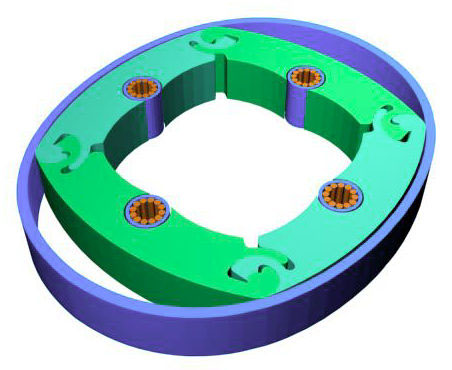
This illustrates some details of a Quasiturbine without
carriage (Model QT-SC).
Other more complex geometries involve carriages (Model QT-AC) as
shown below.
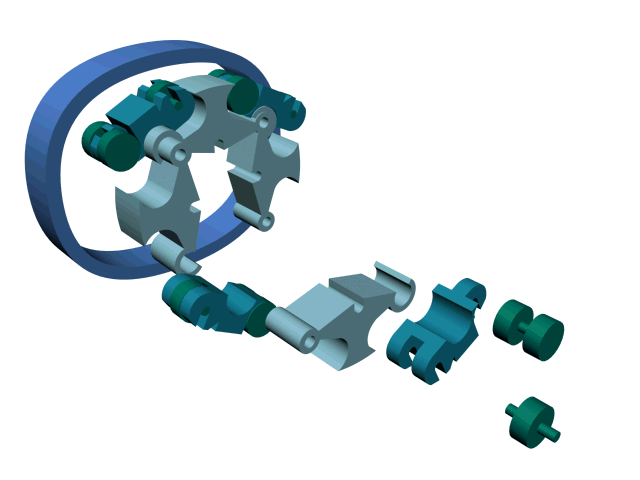
QT-AC (With carriages) is intended for detonation mode,
where high surface-to-volume ratio
is a factor attenuating the violence of detonation.
Furthermore, the eccentricity is also an important geometric factor
which dictates the shape of the stator as a more or less complex oval, to a very
distorted shape still acceptable... The plurality of Quasiturbine designs produces different
pressure and torque characteristics, often very different from the piston and
the Wankel engine, which allows for operation mode not possible with the piston.
Each Quasiturbine device is at the crossroad of the 3 modern engines: Inspired by the turbine, it perfects the piston, and improves on the Wankel.
Improved Characteristics
The
Quasiturbine theory optimizes the use of time by eliminating dead times,
reallocating time among the different engine strokes and replacing the progressive torque impulses with impulse plateaus. This
theory concurrently takes advantage of space by adopting multi-functional and
homo-kinetic engine components which are indispensable at all times during
rotation, and demands continuous flow at the engine's intake and exhaust. This
theory optimizes 14 engine parameters at once and suggests pressure
profiles allowing the detonation.
The Quasiturbine
is a continuous flow engine at intake and exhaust. An engine's piston completes 4 strokes in two rotations, the Quasiturbine completes 32 ! Compressor, pump or turbo-pump
made possible
without any check valve or obstruction.
Continuous combustion, high torque, low
RPM, zero vibration, potentially oil free, fast acceleration, 20 times less noise, less pollution, and high power density (by
a factor of 4) in volume and weight.
Compatible with hydrogen and some Quasiturbine design accepting detonation mode.
Quasiturbine SC - Without Carriage
The SC model has not internal parts - because the center is accessible, all
engine components have a face accessible externally, including through the
center. This property is quite precious in application related to thermal heat
exchanges with the engine block.
When the eccentricity (here 0,578 for the model QT-SC, without carriage) is
chosen such as to produce a straight side on the top and on the bottom, the Saint-Hilaire
skating rink confinement profile is quite obvious:
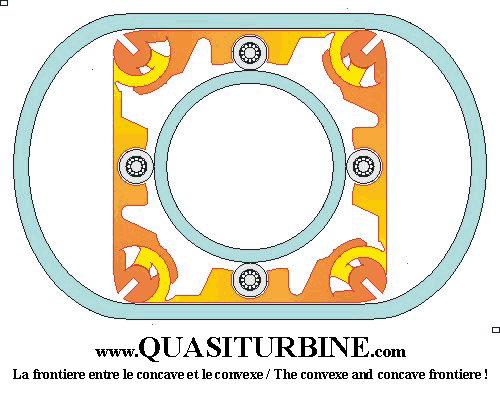
Quasiturbine rotor confinement "Saint-Hilaire skating
rink profile"
This configuration displaces its entire volume every
revolution,
WHAT ABOUT A 3 LITERS DISPLACEMENT ENGINE
INTO A 3 LITERS ENGINE VOLUME!
Eccentricity can be still higher, but for current devices,
a less eccentric
Quasiturbine
is easier to built,
and well able to exceed piston engine performance.
Why does it Turn ?
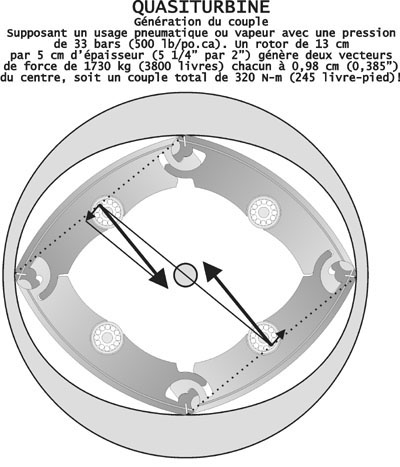
This diagram show the force vector in a Quasiturbine when one or
two opposed chambers are pressurized either by fuel combustion, or by external
pressure fluids. Because the pressure vectors are off center, the Quasiturbine
rotor experiences a net rotational force. It is that simple !
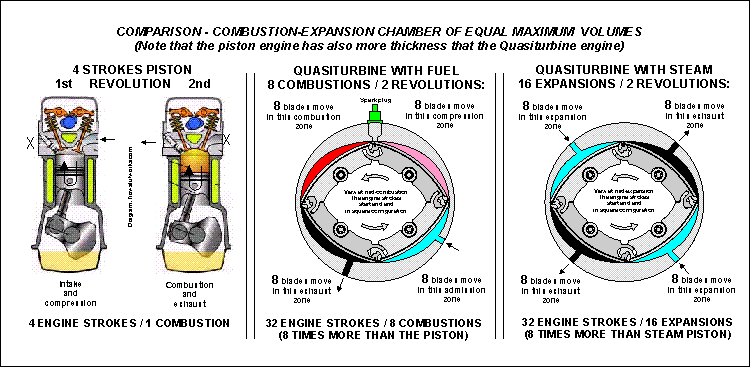
Click here for a 2000 pixels high
resolution image
This diagram compares piston engine with steam and fuel
combustion Quasiturbine.
Quasiturbine AC - With Carriages
More complex Quasiturbine designs can follow from the
defining set of equations. Contrary to the piston or the Quasiturbine QT-SC
(without carriage), which have volume characteristics near sinusoidal, the
more complex Quasiturbine designs can shape the volume pulse almost at will
by varying the parameter sets.
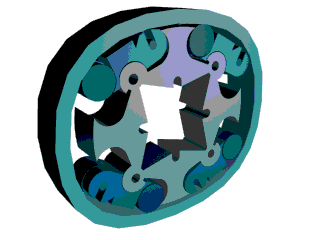
QT-AC (With carriages) is intended for detonation mode,
where high surface-to-volume ratio
is a factor attenuating the violence of detonation.

The parameters for the design below allow to shape the
volume pressure pulse to have a tip 15 to 30 times shorter than the piston,
which provide enhanced torque characteristics for pneumatic and steam
Quasiturbine. But more important, this design is most suitable for detonation
combustion engine mode, a superior mode the piston has failed to support for
over 40 years !
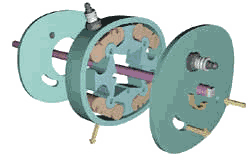
 
Furthermore, in detonation mode, the high
surface-to-volume ratio of this design
is an attenuation factor of the
violence of the detonation.
Pneumatic - Steam
All of the Quasiturbine family designs can be used in pneumatic and steam
mode.
Quasiturbine Uniflow Characteristic
In most reciprocating piston engines, the steam reverses its
direction of flow at each stroke (counter-flow). By entering and exhausting the
cylinder by the same port, the cylinder valve and walls are cooled by the
passing exhaust steam, while the hotter incoming admission steam is wasting some
of its energy in restoring the temperature. Some energy is further lost in
reversing the motion momentum of the mass of steam within the piston. The aim of the piston uniflow is to
remedy this defect by providing an exhaust port at the end of the stroke, making
the steam flowing only in one direction, but has the inconvenience of
recompressing some residual cylinder steam. Quasiturbine is a uniflow engine,
with the further advantage of not recompressing any residual steam, resulting in
superior energy efficiency. Recompressing residual steam means some
reversibility losses, and the pressure increases makes a substantial restriction
to the initial steam flow into the chamber, not to ignore the truncated cycle
near bottom dead center - None of this with the Quasiturbine.
Stirling
The Quasiturbine model SC is particularly
suitable for the Stirling mode (A pure thermal engine without intake and
exhaust).
Detonation Engine
Chemists know that the best way to burn fuel is with intense
laser radiation. The photo-detonation (Auto Ignition) occurs at slightly higher pressure than the
thermal ignition designated in the US as "Homogeneous-Charge
Compression-Ignition" HCCI combustion, in Europe as "Controlled Auto Ignition" CAI
combustion, and in Japan as "Active Thermo-Atmosphere" ATA combustion...
The efficiency at low load factor of the detonation engine is
more than twice that of the conventional Beau de Rocha (Otto) cycle, and considering that the load factor of a car is in average about 10 to 15%, this is not a small difference... Even if the subject
passionates the researchers, the thermic and photonic
ignition control in the piston is still an unsolved problem, and possibly a
dead-end ... that the Quasiturbine does overcome!

In combustion mode, the
Quasiturbine
QT-AC (With carriages)
is suitable for detonation mode,
where high surface-to-volume ratio is a factor attenuating the violence of detonation.
A White Paper
Quantum Parallel: The
Saint-Hilaire "Quasiturbine"
As The Basis For A Simultaneous Paradigm Shift in Vehicle Propulsion
Systems
 Amidst
myriad, and many times unsupportable, claims of technological
breakthroughs capable -- fuel cells being at the top of this contention
-- of inducing vehicular design and engineering paradigm shifts, we have
concluded that the Saint-Hilaire "Quasiturbine" may very well provide
impetus to retire the piston engine. It has served humanity for nearly
two centuries, and has earned its rest. eMOTION!
REPORTS.com is providing a
comprehensive white paper that will perhaps allow you to reach the same
conclusion... Amidst
myriad, and many times unsupportable, claims of technological
breakthroughs capable -- fuel cells being at the top of this contention
-- of inducing vehicular design and engineering paradigm shifts, we have
concluded that the Saint-Hilaire "Quasiturbine" may very well provide
impetus to retire the piston engine. It has served humanity for nearly
two centuries, and has earned its rest. eMOTION!
REPORTS.com is providing a
comprehensive white paper that will perhaps allow you to reach the same
conclusion...
Historical Photos - Quasiturbine AC
Quasiturbine QT50AC - Basic drawings and photos of
prototype.
Quasiturbine QT50AC : Calculated torque, power
and consumption.
More Technical
Why is Quasiturbine
exceptional?
Encyclopedic summary
Quasiturbine differences with the Wankel
Quasiturbine differences with the piston engine
|